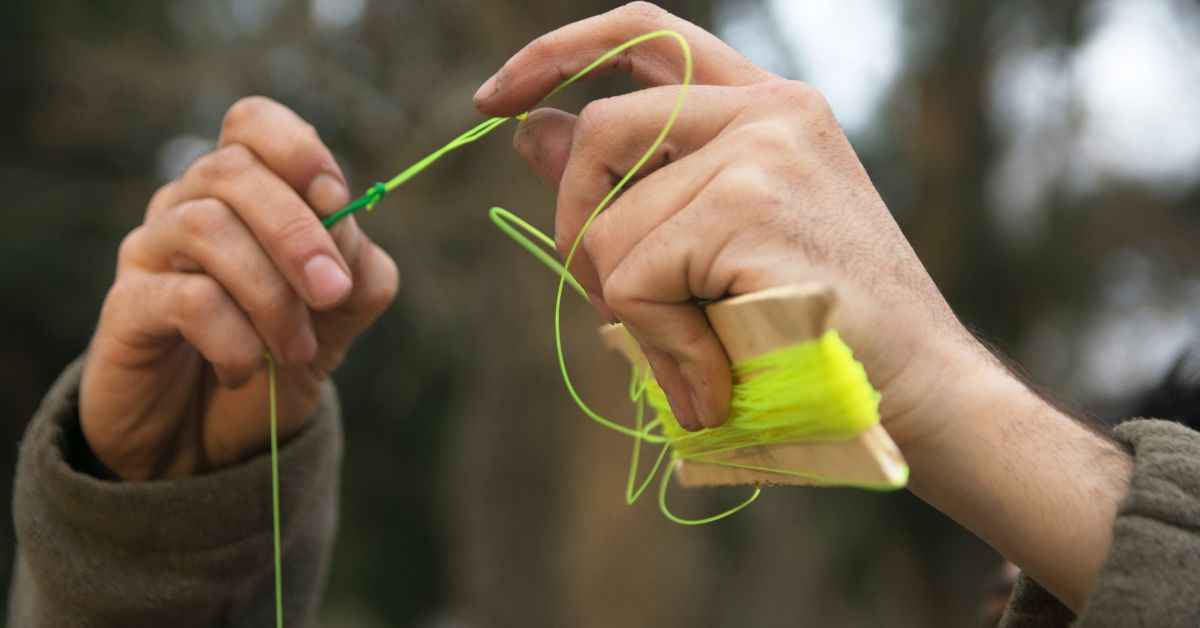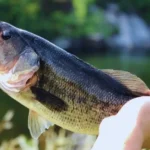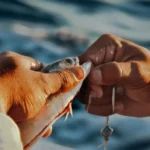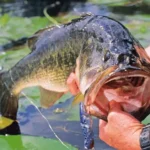Is improving your fishing technique a goal of yours? In such a case, you could question, why use a fluorocarbon fishing line? Compared to monofilament lines, fluorocarbon fishing line has higher sensitivity, decreased visibility, and better abrasion resistance. This article will discuss the advantages of fluorocarbon fishing lines and why some fishermen swear on them. So, why use a fluorocarbon fishing line? Let’s dive in and find out.
What is Fluorocarbon Fishing Line?
Fishing lines constructed from fluorocarbon-based polymers are known as fluorocarbon fishing lines. It is a newer form of fishing line compared to monofilament and braided lines. However, its unique qualities and benefits have made it a fast favorite among fishermen. Fishing using fluorocarbon lines has several benefits, including stealthiness, durability, sensitivity, strength, and abrasion resistance. Its low visibility in the water and high effectiveness as a leader material make it a popular choice.
How is Fluorocarbon Fishing Line Made?
The polymer used to create a Fluorocarbon fishing line contains fluorocarbon. Melting the polymer is the first step in creating a fluorocarbon fishing line, which is then extruded through a die to make the line. The strand is cooled and stretched to realign the molecules and increase their strength. The act of stretching makes the line thinner and easier to handle, which aids in casting and making knots. The bar is then coated with a protective coating after it has been stretched to make it more resistant to abrasion and ultraviolet radiation. The result is a fishing line that is practically undetectable underwater because it is translucent or transparent.
Advantages of Fluorocarbon Fishing Line
Using fluorocarbon fishing line has various benefits over using other forms of fishing line:
- Toughness: Fluorocarbon has been heralded for its superior toughness and tensile strength. It is more abrasion-resistant than monofilament. Therefore it can withstand more significant abuse. It is especially crucial when fishing in rough conditions, where the line is more likely to contact rocks, logs, and other obstacles. It would be terrible if your line broke and you lost your catch. When setting the hook or reeling in a fish, fluorocarbon is less likely to break, making it a more trustworthy option.
- Low Visibility: Because its refractive index is so close to that of water, the fluorocarbon fishing line is nearly undetectable underwater. Because of this, it is a great option for fishing in clear water or luring picky fish.
- Abrasion Resistance: The excellent abrasion resistance of a fluorocarbon fishing line ensures that it will not break or get weakened when rubbing against rocks, weeds, or other underwater obstacles.
- Sinking Properties: When fishing in deep water or employing sinking lures, fluorocarbon fishing is superior to monofilament and braided lines.
- Sensitivity: Anglers may feel even the tiniest nibbles with fluorocarbon fishing lines due to their high sensitivity. When fishing for species noted for having sensitive bites, this is highly crucial.
- Strength and Durability: Compared to a monofilament fishing line, fluorocarbon fishing is more potent, lasts longer, and is less likely to break. It is resistant to environmental factors such as ultraviolet radiation and salinity.
- Stretch: Fluorocarbon fishing line connects the fisherman and the fish more directly since it stretches less than monofilament. Consequently, you can exert more control over the fish and make more precise hook setups.
Anglers looking for a high-performance fishing line that is resistant to the elements, virtually invisible in the water, and has exceptional sensitivity and strength should consider a fluorocarbon fishing line.
The Pros of Using Fluorocarbon Fishing Line
- Invisible underwater: One of the main benefits of fluorocarbon fishing lines is that they are almost invisible underwater. You can’t make a fishing line entirely invisible to fish, but this comes very close.
- Low stretch: Fluorocarbon fishing lines are more responsive to bites because they stretch less than other lines. Thanks to this, you can detect the tiniest edges on your line.
- Abrasion resistant: Compared to other line materials, fluorocarbon lines are more durable and less prone to abrasion and breakage. In this way, they are preferable to other fishing methods in rocky locations where lines tend to get caught.
- Great for finesse fishing: Fluorocarbon fishing lines are highly recommended due to their sensitivity. Detecting the tiniest line twitch can make all the difference if you’re fishing for something finicky like trout.
- Suitable for deep water fishing: Because of their greater density, fluorocarbon fishing lines sink more rapidly than ordinary lines. Because of this, they are a fantastic option for deep-water fishing when you need to cast swiftly.
The Cons of Using Fluorocarbon Fishing Line
- More expensive: The cost of fluorocarbon fishing lines tends to be higher than that of other materials. Some anglers may find this a disadvantage if they are on a restricted budget.
- Stiffer than other lines: Due to their stiffness, casting can be more challenging with fluorocarbon fishing lines. This may be the case if you have never fished with this kind of line.
- More difficult to tie knots: Fluorocarbon fishing lines might be more challenging to tie knots with than other types of bars because they are stronger. Some fishermen, accustomed to effortlessly tying knots, may find this aggravating.
Fluorocarbon vs Monofilament Fishing Line
Both fluorocarbon and monofilament are widely used as fishing lines. There are some significant distinctions between the two varieties, despite the fact that each has its benefits and drawbacks.
- Visibility: Fluorocarbon fishing lines are more transparent than monofilament ones. Since fluorocarbon is so difficult to see underwater, it is ideal for fishing in clear water or catching wary fish. Monofilament is easier to sense in murky water.
- Stretch: Fluorocarbon fishing line connects the fisherman and the fish more directly since it stretches less than monofilament. Better hook settings and fish mastery may arise from this. When fishing for fish that make quick, jerky movements, monofilament’s greater stretch might be an advantage.
- Sensitivity: Anglers may feel even the smallest nibbles with fluorocarbon fishing lines due to their high sensitivity. Since monofilament is not as sensitive, it might be hard to tell whether an animal has been bitten.
- Abrasion Resistance: The excellent abrasion resistance of a fluorocarbon fishing line ensures that it will not break or get weakened when rubbing against rocks, weeds, or other underwater obstacles. Due to its lower abrasion resistance, monofilament may be less durable when repeatedly rubbed against submerged objects.
- Strength and Durability: When compared to a monofilament fishing line, fluorocarbon fishing line is stronger, lasts longer, and is less likely to break. It’s more resistant to environmental factors like UV radiation and seawater than monofilament.
The best fishing line varies on the conditions and the individual tastes of the fisherman, although both fluorocarbon and monofilament have their benefits and drawbacks. If you’re fishing in clear water or trying to catch species that are easily startled, fluorocarbon could be the better option, but if you’re feeling in murky water or trying to see species that make quick, jerky movements, monofilament might be the better choice.
Fluorocarbon vs. Braided Fishing Line
Anglers may choose from a wide variety of fishing lines, including fluorocarbon and braided varieties. The following are some of the main distinctions between the two:
- Visibility: While the vivid colors of the braided line make it easily apparent, the fluorocarbon line is practically undetectable beneath the water. For this reason, fluorocarbon is preferable when fishing in clear water and for catching fish that are readily startled, whereas a braided line may be preferable when fishing in muddy water where visibility is less of an issue.
- Sensitivity: Since fluorocarbon is denser than braided lines, it is more sensitive to biting and other tiny motions and transmits them more effectively. However, since the braided line has almost no flexibility, it might be harder to feel bites but easier to keep a fish under control once it’s hooked.
- Abrasion Resistance: Because of its excellent abrasion resistance, fluorocarbon is not easily damaged by rubbing against rocks and other submerged structures. Similar to monofilament, a braided line is highly abrasion-resistant but may be cut by sharp or abrasive objects.
- Strength: Casting further and handling larger fish is easier with a braided line since it is more robust than fluorocarbon of the same diameter. However, fluorocarbon is superior at preventing knot failure, making it a potentially preferable option in instances when a secure knot is crucial.
- Durability: Fluorocarbon lines are even more resistant to deterioration from exposure to sunshine and other factors than braided lines, which are themselves very robust and resistant to UV radiation.
Ultimately, whether you use fluorocarbon or braided line depends on your individual preferences and the circumstances of the fishing trip. The braided line may be preferable for heavy-duty fishing applications and scenarios where casting distance is an issue, while fluorocarbon may be better for targeting quickly frightened fish in clear water.
When to Use Fluorocarbon Fishing Line
Fluorocarbon fishing line’s near-invisibility, sensitivity, and strength have made it a favorite among fishermen. Some scenarios in which fluorocarbon fishing lines might be useful are listed below.
- Clear Water: Because of its low visibility in the water, the fluorocarbon fishing line is ideal for fishing in clear water or for fishing for fish that are quickly scared. As a result of its stealthy nature, you may be able to catch more fish without scaring them away.
- Bottom Fishing: The abrasion resilience of the fluorocarbon fishing line is beneficial while fishing on the bottom. It may lessen the likelihood of your line breaking due to contact with rocks, logs, and other submerged objects.
- Spinning Reels: Because of its low memory, the fluorocarbon fishing line is well-suited for spinning reels. Many fishermen like it because it reduces the likelihood of knots and increases their throwing range.
- Topwater Fishing: The minimal stretch of fluorocarbon fishing line might make it a good option for topwater fishing. As a result, you may set the hook faster and keep the fish under tighter control.
- Jigging and Drop-Shot Fishing: Because of its sensitivity, fluorocarbon fishing line is often used for jigging and drop-shotting. You’ll be able to feel the fish’s tiniest nibbles and movements, increasing your odds of successfully snaring them.
Fluorocarbon fishing line, in general, is an excellent and flexible option for various kinds of fishing. It is often used by fishermen because of its high sensitivity, high strength, low visibility, and resistance to wear.
Techniques for Fishing with Fluorocarbon Line
Fluorocarbon lines may need a different technique while fishing than monofilament or braided lines. Some tips for using fluorocarbon line in your fishing:
- Tie Knots Correctly: When compared to other forms of line, fluorocarbon is more rigid, making it more difficult to tie knots. To connect your fluorocarbon line to your hooks or lures, use the Palomar or Double Uni knot. These knots may be tied quickly and effectively to secure your line.
- Use Lighter Tackle: Because of its greater density, the fluorocarbon line sinks more rapidly than the monofilament line. When using heavier tackle, this might make casting more challenging. When fishing using a fluorocarbon line, lighter gear, such as spinning rods and reels, may be more effective.
- Pay Attention to Line Stretch: With fluorocarbon line, you’ll feel the fish’s bite sooner since it has less stretch than conventional lines. While this increases your chances of landing the fish, it also requires extra caution while battling the fish to prevent the rope from snapping.
- Keep an Eye on Your Line: Due to the fluorocarbon line’s near-invisibility while submerged, detecting a bite may be challenging. Keep a keen eye on the line for any twitches or other signs of life that might suggest a fish is on the end of it.
- Match Your Leader to Your Line: When fishing for wary fish in clear water, the fluorocarbon line is a common choice for the leader. For maximum setup strength, choose a leader material that is the same diameter as your main line.
- Practice Your Casting: Casting using a fluorocarbon line might be more challenging due to the line’s increased stiffness. Learn how the fluorocarbon line performs in the water by practicing your casting with it.
If you follow these steps, you’ll have a better time fishing using the fluorocarbon line. You’ll be able to reel in more fish with this multipurpose line after some experience.
Tips for Buying Fluorocarbon Fishing Line
There are a few things to keep in mind while searching for the right fluorocarbon fishing line for your requirements. Some advice on where to get the best deals on fluorocarbon fishing line:
- Consider the Strength: There are a variety of pound-test ratings available for fluorocarbon lines. Choose a line that is strong enough to handle the fish you want to catch.
- Look at the Diameter: Because of its smaller diameter compared to the monofilament line of the same strength, the fluorocarbon line might be more difficult to see while fishing in murky water. Choose a diameter that’s suitable for the water conditions where you’ll be fishing.
- Check the Visibility: Some varieties of fluorocarbon lines have a small tint or color that makes them more apparent above water, despite the fact that they are practically undetectable below. Think about whether you want a visible line or if you want everything to be absolutely apparent.
- Look for Abrasion Resistance: Fluorocarbon line is known for its durability and resistance to abrasion. Look for brands that are specifically designed to resist abrasion and prevent breakage.
- Consider the Price: Although the fluorocarbon line is more costly than certain alternatives, it has several advantages. Look for brands that provide a reasonable price and satisfactory quality.
- Read Reviews: Read reviews written by other anglers to get a feel for how well a certain brand or kind of fluorocarbon line works before making a purchase.
Using these guidelines as a guide, you may choose the most effective fluorocarbon fishing line for your situation.
How to Properly Store Fluorocarbon Fishing Line
Keeping your fluorocarbon fishing line in a dry, cool place will help it retain its strength and performance for as long as possible. Here are some suggestions for keeping your fluorocarbon fishing line in good condition:
- Keep it in a Dry Place: Fluorocarbon line may degrade over time if exposed to moisture. Keep your line out of the wet and in a container with a secure top, such as a tackle box.
- Avoid Sunlight: Fluorocarbon line may degrade more rapidly when exposed to sunlight. Store your line in a dark spot or a container that is resistant to UV radiation to prevent it from fading.
- Use Line Spools: Fluorocarbon line is convenient since it often comes on a spool. Avoid getting the line twisted or kinked off the spool since this might cause the line to break.
- Store it Loosely: Keep your line on the spool loosely to avoid memory, which occurs when the line assumes the form of the spool. Having to rely on one’s recollection might make casting a line more challenging and eventually weaken the line.
- Avoid Extreme Temperatures: Fluorocarbon line may be weakened by both very high and low temperatures. To prolong the life of your line, keep it in a cool, dry place like a closet or storage locker.
If you follow these guidelines, your fluorocarbon fishing line will be ready for use when you are.
Conclusion
In conclusion, using a fluorocarbon fishing line may dramatically improve your outings on the water. It is a great choice for fishing in clear water with picky fish because of its low visibility, resilience to abrasion, and sensitivity. So, if you’re looking to up your fishing game, ask yourself, Why use a fluorocarbon fishing line? And consider giving it a try.
Why Use a Fluorocarbon Fishing Line? (F.A.Qs)
What are the benefits of fluorocarbon fishing lines?
Fluorocarbon fishing lines are invisible in water, abrasion-resistant, with minimal strain, and sensitive for improved hook settings.
How does a fluorocarbon line improve your fishing success?
Due to its reduced stretch and superior sensitivity than other lines, fluorocarbon lines increase accuracy, sensitivity, and hook settings.
Is a fluorocarbon line worth the extra cost?
The Fluorocarbon line’s value depends on your fishing demands. It may be worth paying more for a line that is less apparent in water and more sensitive.
What makes fluorocarbon lines better than other types of fishing lines?
Fluorocarbon lines are superior for hook setup and casting since they are less apparent in water, have minimal stretch, and are more sensitive.
How does a fluorocarbon line handle different fishing environments?
Fluorocarbon lines can endure saltwater, freshwater, and deep-sea fishing. It is more resistant to UV rays and seawater than other lines.
What type of fish are best caught with fluorocarbon lines?
Fluorocarbon lines work well for line-shy or sharp-eyed fish like trout and bass and saltwater fish like tuna, snapper, and tarpon.
How do you tie a fluorocarbon line to a hook or lure?
Use a Palomar knot or double uni knot to attach a fluorocarbon line to a hook or bait.
Do Fluorocarbon lines increase fishing rod sensitivity?
Fluorocarbon lines carry more hook vibrations to the rod, allowing you to feel even the smallest bite.
Are fluorocarbon lines more durable?
Fluorocarbon lines survive longer, particularly in tough fishing conditions.
Are fluorocarbon fishing lines harmful?
Fluorocarbon fishing lines cost more and are stiffer, making them tougher to throw. If knotted improperly, fluorocarbon lines may fail knots.











